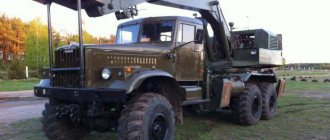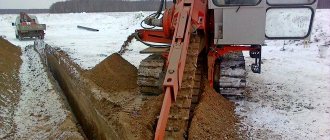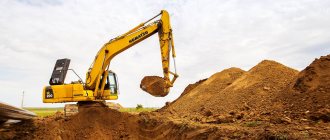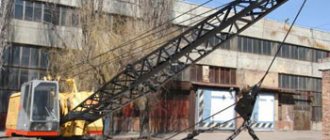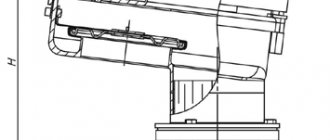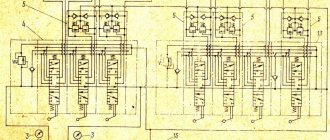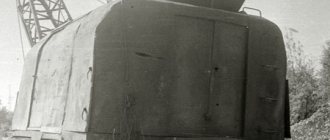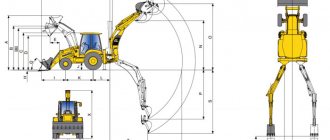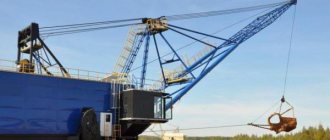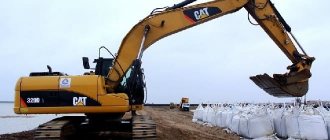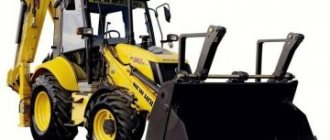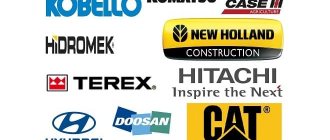Most often, a single-bucket excavator is used to perform excavation work in construction and mining. This is a periodic machine. Its main parameter is the capacity of the bucket (in cubic meters). And all because the bucket is the main working part of an earthmoving machine. But do not forget that there is also a multi-bucket excavator, which is also applicable in specific situations, both on large canal construction projects and quarry work. Thanks to the excavator, it was possible to significantly, tenfold, increase the speed of open-pit mining and construction work.
According to GOST 17343-83, the indexation of single-bucket excavators of new models includes 4 digits, which indicate:
- machine size group (8 positions in total);
- type of running system (caterpillars or wheeled chassis);
- pendant form;
- serial number of the model.
Models produced before the 1970s are designated by an index that specifies: the nominal capacity of the bucket, the serial number of the model and its modernization. And the letters EO mean “single-bucket excavator.”
Main indicators for machines with one bucket
Important technical characteristics of the earth moving machine:
- maximum height and digging depth;
- the largest radius of work;
- the highest possible loading height.
Most often, during construction work, machines equipped with a bucket with a volume of 0.15-4.0 cubic meters are presented. In the LNG territory, soil development is most often carried out using single-bucket excavators of groups 4 and 5 (they have a bucket capacity of 0.65 and 1 m³). Enterprises produce separate versions of excavators with full automation of some production processes.
On any device you can install the following types of working equipment:
- backhoe;
- straight shovel;
- grab;
- dragline.
This equipment allows the single-bucket machine to:
- develop;
- move;
- load and lay soil.
Single-bucket excavators are made universal, equipped with various types of replaceable equipment, which makes it possible to automate many processes, for example, clearing the bottom of excavations or crushing large boulders. In some cases, special attachments make it possible to compact soil on slopes or loosen frozen soil.
Working equipment
Manufacturers of hydraulic excavators are constantly working to improve the main working equipment of machines weighing up to 50 tons - the backhoe. Operating parameters (bucket capacity, digging depth and dumping height) are directly related to the operating weight of excavators. As a result, when designing machines with similar excavator mass values, most companies obtain operating parameters that differ little from each other, as can be seen from the data in Table 1. If any parameter is deliberately changed, this leads to a decrease or increase in other parameters.
In recent years, all companies have also been actively working on the creation, improvement and increase in the number of types of replaceable working equipment and working bodies for the entire range of single-bucket excavators. Depending on the purpose, the range of working equipment and working parts with which excavators are equipped primarily includes various buckets, as well as extended handles, additional handles, extended booms, working equipment with an offset digging axis, shortened working equipment, working equipment for loading timber. , buckets for slope leveling, hooks, buckets with ejector unloading.
Hitachi and Liebherr paid special attention to the development of the design of devices for quickly changing buckets without the operator leaving the cab. A significant expansion of the scope of application of hydraulic excavators was the creation of equipment for them designed for dismantling and destruction of buildings and structures, which is especially important in the reconstruction of cities and industrial enterprises. For the extraction of minerals and building materials in quarries using hydraulic excavators equipped with a straight shovel and a loader, many new types of working bodies have been introduced.
Thus, Hitachi single-bucket excavators weighing 41...44 tons are equipped with a 2.6 m3 loading bucket with an opening bottom and an automatic horizontal extension mechanism. This ensures ease of operation, direct soil development due to high digging forces, and efficient loading of dump trucks in cramped conditions.
Komatsu also equips its 42t excavators with an opening bottom loading system reinforced with a wear plate. The bottom of the bucket is easily opened using a push-button switch at the end of the control lever.
In order to improve maintenance conditions, Kato and Caterpillar-Mitsubishi companies use remote centralized supply of lubricant to the hinges of working equipment located at high heights.
Komatsu also uses a mechanized centralized lubrication system for the hinges of working equipment on large machines with a supply of lubricant for 800-1000 hours of operation.
Using an additional body kit for earthmoving machines
Additional working equipment of a single-bucket excavator allows you to very carefully remove soil for high-precision leveling work, develop trenches for utilities, supply materials and cargo (acting as a loader or crane).
To obtain recesses of various configurations and sizes, profile buckets are used.
To perform tasks using the “soil wall” technology, special rod equipment is used together with an earthmoving machine.
To loosen frozen or very dense soil, single-bucket excavators are equipped with a hydraulic hammer or ripper tooth. To load and remove large stones from a construction site using excavators, additional special equipment can be used, for example, a mounted pincer type.
Soil development using an excavator is carried out only strictly positionally. The area where earthmoving equipment operates, soil is mined, and dump trucks are parked is called the face. The face has a strictly designated, separate place for dumping the developed soil. After completing the task, the excavator is moved to a new location.
Features of auxiliary body kit for excavators
Among the variety of attachments, devices for removing layers of soil, necessary when performing very precise planning or construction work, are in high demand. As well as options for creating neat trenches for engineering systems, pipelines or for supplying bulk products.
To create recesses according to specified parameters, special profile buckets are used.
The “wall in soil” technology is performed using special rod equipment. And to loosen frozen soil or very dense soil, use a hydraulic hammer or ripper tooth.
When loading and removing bulky stones and pieces of soil from the territory, clamp-type attachments are used.
Excavation of soil using a single-bucket excavator is carried out only positionally. The site where work is being carried out with or without the use of additional dump trucks must be fenced. Upon completion of the work, the special equipment is transported to a new location using special vehicles.
How does an excavator work?
Each working cycle of a single-bucket excavator includes a set of operations of a certain order:
- cutting soil and filling a bucket with it;
- lifting a bucket with collected rock;
- turning the excavator around its axis to the dump site;
- directly dumping the soil from the bucket;
- turning the excavator in the opposite direction;
- Lowering the bucket to repeat the soil filling procedure.
Single-bucket excavators (EB) must dig:
- pits and crankcases;
- trenches and excavations of a given geometry;
- load the soil onto dump trucks or dump it at the specified location.
The size of the excavation that a single-bucket machine can make from 1 stop depends on its parameters.
When planning excavation operations, designers must position the excavator to minimize the angle of rotation from where the bucket is loaded with sediment until it is dumped onto a dump or truck bed. Taking into account the operating features of this machine, 70% of its total working time is spent turning the boom (first with the load to the truck or dump site, and then back to the mining site), so they try to minimize this indicator, reducing working hours and increasing efficiency of use .
Turntables with mechanisms
On the rotating platform of hydraulic excavators, a power plant, units and components of the drive system, a turning mechanism and a driver’s cabin with a control panel are placed.
When developing the design of a turning mechanism, two main tasks are solved: creating a compact unit and ensuring efficient operation of the machine during the process of turning the platform. The first problem is solved by using planetary gearboxes on many excavators, the second is by using an independent drive of the turning mechanism and a modern control system.
To prevent arbitrary rotation of the platform when the excavator is on slopes, as well as to safely carry out operations with a load on the hook, Komatsu installs a parking brake on the turntable.
| Hydraulic excavator EO-5225 (TYAZHEKS) | Hydraulic excavator EO-4228 (JSC KEZ) |
Firms mainly use the traditional layout of units. Some companies use a longitudinal central or longitudinal lateral engine arrangement. Hydraulic distributors are placed near the boom or directly on the boom, while installing the boom hydraulic cylinders with the rod down. It is characteristic that Case-Poclain has abandoned the use of high-torque hydraulic motors of its own manufacture in the mechanisms for turning the platform and moving hydraulic excavators and in recent years has been using a gearmotor from Volvo (Sweden), which organized their special production.
Liebherr uses a hydraulic motor and a planetary gearbox of its own production to drive the turning mechanism. In the swing drive, the normally closed disc brake built into the gearbox is stopped; The slewing ring is sealed.
On the EO-5225 excavators of the Voronezh plant, to improve vibration and noise indicators in the cabin, a diesel engine with a hydraulic system pump drive gearbox is installed on the platform through shock absorbers.
How are earthmoving machines classified?
There is a classification of single-bucket excavators, which allows in each specific case to use a machine with the necessary characteristics as efficiently as possible.
The main parameters in this case are:
- excavator type;
- bucket capacity;
- boom length;
- cutting radius.
When choosing additional equipment for an excavator, take into account the nature of the excavation being developed (pit or trench) and groundwater (depth of its occurrence).
Most often, single-bucket construction excavators like a “straight shovel” are used on construction sites where it is necessary to select soil above the parking lot of the earthmoving machine and load it onto trucks.
Typically, equipment can be found in quarries, at construction sites for loading soil or excavating pits (in this case, the machine is placed so that there is a ramp for it and trucks with a slope of 10-15%).
A straight shovel is a bucket (with a capacity of 0.15-2.5 m³) with an open top and a cutting front edge, hingedly connected to the handle, which in turn is hinged to the boom. Structurally, such an excavator will be able to work only in the face area above the parking level (optimally with a height of 1.5 m, the permissible threshold is 0.1-0.2 m lower).
Classification of single-bucket excavators
Single-bucket excavators are classified according to:
- chassis type;
- drive type;
- type of working equipment;
- the possibility of rotating the working equipment relative to the supporting surface.
2.1 Classification based on the possibility of rotation of the working equipment relative to the supporting surface
Based on the possibility of rotating the working equipment relative to the supporting surface, single-bucket excavators are divided into semi-rotary and full-rotary.
Full rotation (Fig. 6).
Rice. 6. Diagram of a full-rotary excavator. Click on the picture to enlarge
The working equipment, drives, driver's cabin and engine are installed on a turntable, which in turn is mounted on the chassis by means of a slewing support device (SDU), and can be rotated relative to it in any direction at any angle. Parts of the hydraulic system of the chassis and rotating platform of full-rotary excavators are connected using a manifold, which allows an unlimited number of full revolutions in one direction.
Partial rotation (Fig. 7). The working equipment is fixed to the chassis using a rotating column. On many machines of this type, the rotary column is mounted on transverse guides, which allows it to be moved together with the working equipment from right to left, followed by rigid fixation for a more convenient position of the working equipment. The rotation of the working equipment is carried out at an angle of 45-90 degrees from the initial position. The engine, mechanisms, and driver's cabin are located on a fixed chassis. Currently, excavators mounted on tractors are part-rotary.
Rice. 7. Diagram of a part-turn excavator on a wheeled tractor chassis. Click on the picture to enlarge
1 — excavator frame mounted on the tractor; 2 - Rotary column; 3 - Arrow;
4 - Handle; 5 - Boom drive hydraulic cylinder; 6 - Hydraulic cylinder for handle drive;
7 — Hydraulic cylinder for bucket drive; 8 - Bucket; 9 — Option for installing the bucket in the backhoe position; 10 — Replaceable cargo hook; 11 - Bulldozer blade; 12. — Outriggers
2.2. Classification by chassis type
Single-bucket excavators by chassis type can be tractor-mounted, automobile-mounted, pneumatic-wheeled, tracked, walking, railway, or floating.
Mounted on a tractor (Fig. 8). A tractor, most often a wheeled one, is used as the base chassis. Partial rotation excavator equipment is installed at the rear (less often on the side) of the tractor, on a special frame. The characteristic volume of the bucket is 0.2...0.5 m?. They are used to perform small excavation or loading work, most often when repairing utility networks. The design of the working equipment allows you to quickly rearrange the bucket for working with a front or backhoe. The bucket can be replaced with a grab, forks or a hook. The engine of the base tractor is used for drive. The drive of the working equipment is hydraulic. Thanks to the relatively high speed, they can quickly arrive at the work site located at a distance of 20...30 km from the base. A tractor with attached excavator equipment can also be used to perform transport and bulldozer work.
Rice. 8. Single-bucket excavators mounted on a tractor
On a car chassis (Fig. 9). A truck, most often an off-road vehicle, is used as the base chassis. They have a high speed of movement. They are used in cases where high mobility is required: in military affairs (engineering troops, road troops), when performing rescue operations, during road construction, and canal cleaning. The working equipment is mainly a backhoe. Excavators are produced with a telescopic boom and a rotating bucket, which allows you to quickly switch from a straight shovel to a reverse shovel. The drive can use either the engine of the base vehicle or a separate engine installed on the turntable.
Rice. 9. Single-bucket excavator on a car chassis
Pneumatic wheeled excavators (Fig. 10) have their own special chassis, supported by wheels with pneumatic tires. To increase stability and prevent slipping when loading the bucket, they have outriggers. They have a travel speed of up to 30 km/h. Can be towed by trucks at speeds up to 40 km/h. Passability on soft soils is limited. They are produced in a wide range of size groups - from microexcavators with a bucket volume of 0.04 m2 to heavy wheeled excavators with a bucket volume of up to 1.5 m2. Due to the specifics of the work performed: development of pits, trenches, leveling work - working equipment - mainly a backhoe. Can be used with a grab, jaw grip, or hydraulic hammer for loosening soil. They are widely used when performing various types of construction and repair work.
The chassis wheels can be driven either from the engine of the working equipment through mechanical or hydraulic transmissions (hydraulic motors), or from a separate engine.
Rice. 10. Crawler single-bucket excavator
Crawler single-bucket excavators have their own special chassis with a caterpillar drive. They have high maneuverability and low specific pressure on the ground with a large mass. They can work on weak and waterlogged soils, including peat mining. They have a travel speed of 2…15 km/h. They are transported to the work site by tractors on special trawls.
The working range of bucket volumes is very wide: from mini excavators with a bucket volume of 0.04 m3 to quarry excavators with a bucket volume of 10 m3. There are also particularly heavy mining crawler excavators with a bucket volume of 26 m3 produced by DEMAG (Germany).
Working equipment: straight shovel, backhoe, dragline. Can be used with a grab, jaw grip, hydraulic hammer for loosening soil. They are widely used in construction and mining. A number of models of crawler and pneumatic wheeled excavators have a unified rotary platform and working equipment.
Walking single-bucket excavators (Fig. 11). The rotary platform with the walking excavator equipment is installed on the base plate. The paws are connected to the turntable, which are raised when the excavator is operating (do not touch the ground). When the excavator moves, the paws rest on the ground. In this case, the base plate is lifted off the ground. The excavator moves one step forward (for some models it is possible to move backward). After this, the paws rise and return to their original position. Large mining excavators with a bucket volume of 15...40 m3 and a boom reach of up to 65...150 m are produced at walking speed. The working equipment is a dragline. Walking excavators perform stripping work (clearing mineral deposits from waste rock), as well as extracting minerals and moving them to a dump (up to 40 m high). Loading of minerals by walking excavators into vehicles cannot be carried out.
Rice. 11. Walking bucket excavator
Railway single-bucket excavators (Fig. 12). A railway platform is used as an excavator chassis. Used for repair work on railways. They have a bucket volume of up to 4 m3. The rotary platform and equipment are often unified with crawler excavators.
Rice. 12. Railway bucket excavator
Floating single-bucket excavator (Fig. 13). The working equipment (dragline or grab) is installed on the pontoon. They are used for loading and unloading operations, extraction of sand, gravel from reservoirs, bottom cleaning and dredging work. Floating excavators differ from floating cranes equipped with grabs by their smaller height and simplified boom design.
Rice. 13. Floating bucket excavator
2.3. Classification of single-bucket excavators by engine type
Single-bucket excavators can be steam, internal combustion, or electric by engine type.
Steam excavators - a steam engine is used as an engine. They were common at the beginning of the 20th century. Currently not in production.
Excavators with internal combustion engines are the most common type. The excavator has its own engine, most often a diesel one. This ensures autonomy of operation. The power range of engines installed on modern excavators is very wide.
Electric excavators - electric motors are used to drive working equipment, receiving energy from an external network or from its own diesel-electric unit. An electric drive powered from an external network is used for mining excavators. Such excavators are economical and do not pollute the quarry atmosphere. An electric drive powered by its own diesel-electric unit is used in floating excavators. The electric motor produces torque when the armature is braked, so an electric excavator does not require complex mechanical transmissions.
Excavators operating in explosive environments (in mines) do not have a prime mover. Their hydraulic equipment is supplied with high pressure fluid from an external oil station.
2.4 Classification by type of mechanical transmissions (drives of working equipment)
Based on the type of mechanical transmission, single-bucket excavators are divided into mechanical, electromechanical and hydraulic driven.
Mechanical. The traction force to the working parts is transmitted through ropes (or chains) driven by winches.
Mechanical rope drive has been widely used on excavators in the past.
On modern models, a mechanical cable drive is used only for a dragline or grab.
Electromechanical. The traction force to the working parts is transmitted through ropes (or chains) driven by winches. Each winch and auxiliary mechanisms are driven by an individual electric motor. This drive is used on heavy mining (including walking) and industrial excavators
Excavators with hydraulic drive. In hydraulically driven excavators, the force on the elements of the working equipment is created by hydraulic cylinders and hydraulic motors. The excavator engine rotates a hydraulic pump, which creates pressure of the working fluid in the pressure line of the hydraulic system.
Currently, hydraulic excavators are predominantly used.
Dragline type machine
Most often, dragline-type single-bucket excavators are used where it is necessary to work with soil below the parking lot. They can:
- dig deep pits and wide trenches;
- build embankments;
- develop soil from under water.
The dragline has a radius of action of 10 m and a digging depth of almost 12 m. It is ideal for clearing slopes and grading large areas. With these types of machines, the construction site is not afraid of the level of ground moisture and the type of soil (both soft and hard).
The dragline design involves the use of a long crane-type boom and a bucket suspended on ropes.
For efficient operation, the production pattern can be cross-shuttle or longitudinal-shuttle. These use cases allow you to reduce the machine's turning angle and bucket lift height, thereby increasing its productivity by almost 2 times. Plus, buckets are used here with a volume of up to 2.5 m³. For planning large areas that require the construction of a pile foundation, these excavators are the best solution. In addition, all work on the creation of marine facilities (ports, bridges, tunnels and ship docks) is associated with this brand of excavator.
“Backhoe” and “grab” type equipment
When highly specialized work is required, for example, excavating a deep and narrow pit or trench, we use a grab. You can use it to dig a well.
A grab is a bucket with 2 blades or more, and a pointer (previously a rope) drive that closes the blades. These self-propelled vehicles are used in the development of excavations with vertical walls. Due to the design features, this excavator is supposed to be used on soils of any density. Machines of this type are used together with buckets of various volumes (from 0.35 to 2.5 m³).
The “backhoe” is used to implement trenches with a depth of up to 7 m and pits of 6 m. These types of construction have slightly lower productivity than the “straight shovel” product, but are more durable and versatile (the width of the face is limited only by the maneuverability).
Externally, a backhoe looks like a bucket open at the bottom, which has a cutting front edge and a hinged connection to the handle.
GOST, operating in the CIS, states that universal all-wheel drive excavators must be equipped with a backhoe.
Main characteristics for single-bucket models
The main technical parameters of any type of single-bucket excavators include:
- maximum height and depth of digging;
- maximum radius of work;
- maximum boom length – permissible loading parameter.
When carrying out various construction works, excavators equipped with a bucket with a volume of 0.15 to 4 m³ are most often used (purchased or rented). In the CIS countries, machines of groups 4 or 5 are used much more often, the bucket capacity of which varies from 0.65 to 1 cubic meter. A number of manufacturers supply the market with special equipment with full automation of a number of work options (processes).
At the same time, auxiliary attachments can be installed on any unit. This includes:
- backhoe or straight shovel;
- grab;
- dragline.
Such devices allow not only digging, but also developing, mixing, loading and storing soil.
In addition to the listed devices, replaceable equipment for process automation is often installed on single-bucket excavators. For example, for cleaning the bottom of excavations or crushing large boulders. There are options for attachments for compacting soil on slopes or breaking up frozen soil.
How earthmoving machines are selected
To increase the efficiency of use, it is necessary to carry out a preliminary calculation of a single-bucket excavator according to:
- loads;
- drive type;
- designs;
- available work equipment.
To calculate and select the configuration of an earthmoving machine bucket, take into account the forces acting on it:
- drive lift;
- pressure transmitted through the hinges and rods of the handle;
- resistance of soil masses and their impact on the teeth;
- gravity.
To find out the strength of the bucket, you need to calculate the load on its walls, which, to increase strength, are made ribbed, of a complex configuration with variable thickness.
Next, the handle is calculated, the main stresses in it are bending and twisting. Therefore, calculations are carried out according to 2 provisions. A single-beam handle is considered as a cantilever beam in the first (the handle beam is embedded in the bucket) position and the second (the beam is in the saddle bearing).
The parameters for using a particular excavator model are influenced by calculations of the boom for the rigidity and strength of its main sections near the heel and the pressure shaft. In addition, the lateral thrusts and axes of the head blocks are subject to calculation.
The hydraulic control circuit is shown in the figure (see diagram) and works as follows:
The hydraulic circuit is functionally divided into two control units for hydraulic cylinders and hydraulic motors for turning the platform and driving the excavator and hydraulic cylinders for moving the working parts. The hydraulic system is equipped with a dual pump 2 with a power regulator, which is designed to adjust the pump flow depending on the external load, because when the working force on the working body increases, its speed decreases, and with a decrease in force, it increases, while the power must remain constant.
From the first block of the pump 2, the working fluid—oil—is supplied to the three-spool block of hydraulic distributors 4, which control the hydraulic cylinders of the outriggers 7 (for excavators on pneumatic wheels), the hydraulic motor for turning the platform 8, and the hydraulic motor for driving the excavator 9. A safety valve is built into this section. ensuring oil drainage when the pressure rises above the permissible level. The rodless cavity of the hydraulic cylinder 7, with the hydraulic spool in the neutral position, is locked with a hydraulic lock 6, which does not allow the unit to lower due to oil leaks from the system.
Valve 5 is attached to the hydraulic spool assemblies that control hydraulic motors 8 and 9, which ensures smooth beginning and end of movement of the controlled element. From the second section of pump 2, oil is supplied to the spool block 13, which controls the stroke of the second hydraulic motor 9, the hydraulic cylinders of the boom 10, bucket 14 and handle 12. When all the spools of block 4 are in the neutral position, under the action of the return springs, oil is under pressure from the first section pump 2, enters through the hydraulic spool block 4 into the hydraulic spool block 13, increasing the speed of the working bodies controlled by this block.
Between the second and fourth hydraulic spools of block 13, another spool is installed, which, when turned on at the same time, ensures the combination of movements of the handle, bucket, boom and rotation of the platform. Valve blocks 5 ensure smooth operation at the beginning and end of the movement of the working bodies. The speed of movement of all working parts is adjusted using throttles, and the cleanliness of the oil is ensured by the presence of filters. Auxiliary pump 14 is designed to fill the system with oil through a cleaning filter. The hydraulic system is equipped with pressure gauges and a thermometer to monitor the condition of the oil.
Modern excavators combine high productivity, low specific energy consumption, versatility, high specific power, and a high level of automation, which makes them irreplaceable in any type of construction work and in the extraction of ore materials.
Benefits of the latest hydraulic excavators
It is important to remember that the operational productivity of hydraulic excavators is much higher than that of other types of earthmoving machines. Especially if you take into account universal all-terrain tracked vehicles with a weight of 10-50 tons.
The internal structure of a hydraulic type single-bucket excavator gives it the following advantages:
- increased productivity compared to machines using mechanical (rope drive);
- reduced specific energy and material consumption of the machine;
- versatility, thanks to a large number of replaceable equipment (up to 40 different working bodies);
- increased power and automation of work processes;
- comfortable conditions for the driver (the productivity of his work increases);
- changing the appearance of the car, greater aesthetics;
- increasing operational efficiency due to the greater performance of off-road tracked platforms.
There is a separate subtype of mini-excavators designed to replace manual labor during repair work in the city (laying new or servicing existing utility networks and communications).
NOE can be equipped with various types of working bodies:
a bucket installed in the form of a front and back shovel, a hydraulic hammer, a pincer grip, and a crane-type hook. These mounted working parts are designed for universal use of the NOE, and therefore for its more efficient operation as a piece of equipment. Using a mounted hydraulic hammer, monolithic pieces of rock are destroyed before loading. The pincer gripper is used for loading non-destructible monolithic pieces and large piece goods.
Hook suspension is used for hanging and transporting transport containers with various cargo.
Devices that change reality
There are different types of excavators, differing in the type of bucket, drive, platform (wheeled or tracked), and size (regular and miniature). Their main task was to replace manual labor in heavy earthworks. It was thanks to these machines that it was possible to increase the pace of construction (both residential and industrial) and the development of natural resources.
Each use of the machine was designed to minimize waste and maximize productivity. Effective techniques increase overall labor efficiency, which means they create added value for manufactured products and move progress further.
After all, excavation work requires up to 50% of all costs for construction or development of open-pit mining sites.
Before ordering a rental excavator, you should consult with experienced engineers or designers, select the brand and type of earthmoving machine, and only then enter into a rental agreement. If you plan to use a universal machine, it is worth calculating at least its most efficient positioning (with the smallest rotation angle).
Operating principle of special equipment
During operation, a bucket excavator performs a whole cycle of certain operations. All of them are performed in a strictly defined sequence:
- Cutting the soil and filling the bucket with it.
- Raising a bucket with collected soil.
- Rotating the equipment around its axis to the place of dumping.
- Dump (unloading).
- Turn back to the material collection (digging) point.
- Lowering the bucket to repeat all stages of work.
At the same time, single-bucket excavators are capable of performing the following tasks:
- dig pits, quarries, craters;
- create trenches and excavations according to specified technical parameters (TS);
- load the kidney onto dump trucks or dump it at a specified location.
The parameters of excavations that one excavator can create depend on the technical characteristics of the equipment.
When planning excavation work, civil engineers or designers are required to position the excavator to minimize the angle of rotation. This affects the speed of operation of special equipment. Taking into account the design and technical parameters of the machines, 70% of the operating time is spent on turns.
